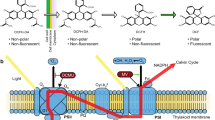Abstract
In this paper, we determine for the first time the in vivo effect of heavy metals in a phototrophic bacterium. We used Confocal Laser Scanning Microscopy coupled to a spectrofluorometric detector as a rapid technique to measure pigment response to heavy-metal exposure. To this end, we selected lead and copper (toxic and essential metals) and Microcoleus sp. as the phototrophic bacterium because it would be feasible to see this cyanobacterium as a good biomarker, since it covers large extensions of coastal sediments. The results obtained demonstrate that, while cells are still viable, pigment peak decreases whereas metal concentration increases (from 0.1 to 1 mM Pb). Pigments are totally degraded when cultures were polluted with lead and copper at the maximum doses used (25 mM Pb(NO3)2 and 10 mM CuSO4). The aim of this study was also to identify the place of metal accumulation in Microcoleus cells. Element analysis of this cyanobacterium in the above mentioned conditions determined by Energy Dispersive X-ray microanalysis (EDX) coupled to Scanning Electron Microscopy (SEM) and Transmission Electron Microscopy (TEM), shows that Pb (but not Cu) accumulates externally and internally in cells.





Similar content being viewed by others
References
Diestra E, Solé A, Marti M, García de Oteyza T, Grimalt JO, Esteve I (2005) Characterization of an oil-degrading Microcoleus consortium by means of confocal scanning microscopy, scanning electron microscopy and transmission electron microscopy. Scanning 27:176–180
Goldberg J, Gonzalez H, Jensen TE, Corpe WA (2001) Quantitative analysis of the elemental composition and the mass of bacterial polyphosphate bodies using STEM EDX. Microbios 106:177–188
Gong R, Ding Y, Liu H, Chen Q, Liu Z (2005) Lead biosorption and desorption by intact and pretreated Spirulina maxima biomass. Chemosphere 58:125–130
Li PF, Mao ZY, Rao XJ, Wang XM, Min MZ, Qiu LW, Liu ZL (2004) Biosorption of uranium by lake-harvested biomass from a cyanobacterium bloom. Bioresour Technol 94:193–195
Massieux B, Boivin ME, Van Den Ende FP, Langenskiold J, Marvan P, Barranguet C, Admiraal W, Laanbroek HJ, Zwart G (2004) Analysis of structural and physiological profiles to assess the effects of Cu on biofilm microbial communities. Appl Environ Microbiol 70:4512–4521
Milloning G (1961) Advantages of a phosphate buffer for OsO4 solutions in fixation. J Appl Phys 32:1637–1656
Pfennig N, Trüper HG (1992) The family of Chromatiaceae. In: Balows A, Trüper HG, Dworkin M, Harder W, Schleifer KH (eds) The prokaryotes, 2nd edn. Springer, Berlin, pp 3200–3221
Roldan M, Thomas F, Castel S, Quesada A, Hernandez-Marine M (2004) Noninvasive pigment identification in single cells from living phototrophic biofilms by confocal imaging spectrofluorometry. Appl Environ Microbiol 70:3745–3750
Sánchez O, Diestra E, Esteve I, Mas J (2005) Molecular characterization of an oil-degrading cyanobacterial consortium. Microb Ecol 50:580–588
Sicko LM (1972) Structural variations of polyphosphate bodies in blue-green algae. In: Arceneaux J (ed) 30th annual proceedings of the Electron Microscopy Society of America. Los Angeles, California
Sole A, Diestra E, Esteve I (2009) Confocal laser scanning microscopy image analysis for cyanobacterial biomass determined at microscale level in different microbial mats. Microb Ecol 57:649–656
Solé A, Mas J, Esteve I (2007) A new method based on image analysis for determining cyanobacterial biomass by CLSM in stratified benthic sediments. Ultramicroscopy 107:669–673
Solisio C, Lodi A, Torre P, Converti A, Del Borghi M (2006) Copper removal by dry and re-hydrated biomass of Spirulina platensis. Bioresour Technol 97:1756–1760
Stevens SE Jr, Nierzwicki-Bauer SA, Balkwill DL (1985) Effect of nitrogen starvation on the morphology and ultrastructure of the cyanobacterium Mastigocladus laminosus. J Bacteriol 161:1215–1218
Acknowledgments
This research is supported by Spanish grant DGICYT (Ref. CGL2005-03792/BOS and CGL2008-08191/BOS) and by Generalitat de Catalunya grant ITT-CTP (Ref. 2007ITT 00003). The authors express their thanks to all of the staff of the Servei de Microscòpia at the Autonomous University of Barcelona for their valuable technical assistance. We also thank Marc Alamany and Francesc Fornells from Ecología Portuaria S.L. (Spain), who provided valuable comments on the manuscript.
Author information
Authors and Affiliations
Corresponding author
Rights and permissions
About this article
Cite this article
Burnat, M., Diestra, E., Esteve, I. et al. Confocal Laser Scanning Microscopy Coupled to a Spectrofluorometric Detector as a Rapid Tool for Determining the In Vivo Effect of Metals on Phototrophic Bacteria. Bull Environ Contam Toxicol 84, 55–60 (2010). https://doi.org/10.1007/s00128-009-9907-1
Received:
Accepted:
Published:
Issue Date:
DOI: https://doi.org/10.1007/s00128-009-9907-1




